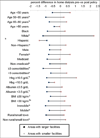Effects of physician payment reform on provision of home dialysis
- PMID: 27355909
- PMCID: PMC5055389
Effects of physician payment reform on provision of home dialysis
Abstract
Objectives: Patients with end-stage renal disease can receive dialysis at home or in-center. In 2004, CMS reformed physician payment for in-center hemodialysis care from a capitated to a tiered fee-for-service model, augmenting physician payment for frequent in-center visits. We evaluated whether payment reform influenced dialysis modality assignment.
Study design: Cohort study of patients starting dialysis in the United States in the 3 years before and the 3 years after payment reform.
Methods: We conducted difference-in-difference analyses comparing patients with traditional Medicare coverage (who were affected by the policy) to others with Medicare Advantage (who were unaffected by the policy). We also examined whether the policy had a more pronounced influence on dialysis modality assignment in areas with lower costs of traveling to dialysis facilities.
Results: Patients with traditional Medicare coverage experienced a 0.7% (95% CI, 0.2%-1.1%; P = .003) reduction in the absolute probability of home dialysis use following payment reform compared with patients with Medicare Advantage. Patients living in areas with larger dialysis facilities (where payment reform made in-center hemodialysis comparatively more lucrative for physicians) experienced a 0.9% (95% CI, 0.5%-1.4%; P < .001) reduction in home dialysis use following payment reform compared with patients living in areas with smaller facilities (where payment reform made in-center hemodialysis comparatively less lucrative for physicians).
Conclusions: The transition from a capitated to a tiered fee-for-service payment model for in-center hemodialysis care resulted in fewer patients receiving home dialysis. This area of policy failure highlights the importance of considering unintended consequences of future physician payment reform efforts.
Figures


Similar articles
-
Bundled Payment Reform and Dialysis Facility Closures in ESKD.J Am Soc Nephrol. 2020 Mar;31(3):579-590. doi: 10.1681/ASN.2019060575. Epub 2020 Feb 4. J Am Soc Nephrol. 2020. PMID: 32019784 Free PMC article.
-
For Medicare's New Approach To Physician Payment, Big Questions Remain.Health Aff (Millwood). 2016 Sep 1;35(9):1643-6. doi: 10.1377/hlthaff.2016.0939. Health Aff (Millwood). 2016. PMID: 27605645 Review.
-
Hemodialysis Hospitalizations and Readmissions: The Effects of Payment Reform.Am J Kidney Dis. 2017 Feb;69(2):237-246. doi: 10.1053/j.ajkd.2016.08.033. Epub 2016 Nov 14. Am J Kidney Dis. 2017. PMID: 27856087 Free PMC article.
-
Medicare's New Quality Payment Program Has Started-Are You Ready?Arch Pathol Lab Med. 2017 Jun;141(6):741-745. doi: 10.5858/arpa.2017-0047-ED. Epub 2017 Mar 13. Arch Pathol Lab Med. 2017. PMID: 28557597 No abstract available.
-
The changing landscape of home dialysis in the United States.Curr Opin Nephrol Hypertens. 2014 Nov;23(6):586-91. doi: 10.1097/MNH.0000000000000066. Curr Opin Nephrol Hypertens. 2014. PMID: 25197946 Free PMC article. Review.
Cited by
-
Financial Incentives to Facilities and Clinicians Treating Patients With End-stage Kidney Disease and Use of Home Dialysis: A Randomized Clinical Trial.JAMA Health Forum. 2022 Oct 7;3(10):e223503. doi: 10.1001/jamahealthforum.2022.3503. JAMA Health Forum. 2022. PMID: 36206005 Free PMC article. Clinical Trial.
-
Health Insurance and the Use of Peritoneal Dialysis in the United States.Am J Kidney Dis. 2018 Apr;71(4):479-487. doi: 10.1053/j.ajkd.2017.09.024. Epub 2017 Dec 23. Am J Kidney Dis. 2018. PMID: 29277511 Free PMC article.
-
Home Dialysis in the Prospective Payment System Era.J Am Soc Nephrol. 2017 Oct;28(10):2993-3004. doi: 10.1681/ASN.2017010041. Epub 2017 May 10. J Am Soc Nephrol. 2017. PMID: 28490435 Free PMC article.
-
Championing the Dialysis Patient Voice: How has the US Legislation Fared?Kidney360. 2024 Nov 1;5(11):1744-1746. doi: 10.34067/KID.0000000000000560. Epub 2024 Aug 21. Kidney360. 2024. PMID: 39167483 Free PMC article. No abstract available.
-
Association between change in physician remuneration and use of peritoneal dialysis: a population-based cohort analysis.CMAJ Open. 2020 Feb 18;8(1):E96-E104. doi: 10.9778/cmajo.20190132. Print 2020 Jan-Mar. CMAJ Open. 2020. PMID: 32071144 Free PMC article.
References
-
- Burwell SM. Setting value-based payment goals--HHS efforts to improve U.S. health care. New England Journal of Medicine. 2015 Mar 5;372(10):897–899. - PubMed
-
- Steinbrook R. The Repeal of Medicare's Sustainable Growth Rate for Physician Payment. JAMA. 2015;313(20) - PubMed
-
- USRDS. Annual Data Report: Atlas of Chronic Kidney Disease and End-Stage Renal Disease in the United States. Bethesda, MD: National Institutes of Health, National Institute of Diabetes and Digestive and Kidney Diseases; 2013.
-
- King K. Patients' perspective of factors affecting modality selection: a National Kidney Foundation patient survey. Advances in Renal Replacement Therapy. 2000 Jul;7(3):261–268. - PubMed
-
- Boateng EA, East L. The impact of dialysis modality on quality of life: a systematic review. Journal of Renal Care. 2011 Dec;37(4):190–200. - PubMed
Publication types
MeSH terms
Grants and funding
LinkOut - more resources
Full Text Sources
Medical
